Cardiogenic Shock Case Study Report: Analysis and Management
VerifiedAdded on 2023/04/25
|8
|2071
|230
Report
AI Summary
This report provides a comprehensive analysis of a cardiogenic shock case study involving a 57-year-old male patient presenting with acute myocardial infarction. The report begins with an assessment of the patient's clinical manifestations, including disorientation, chest pain, diaphoresis, and abnormal vital signs. It identifies the underlying pathophysiology of cardiogenic shock, focusing on the impact of reduced cardiac output and oxygenation. The report then differentiates cardiogenic shock from other types of shock, such as septic shock, highlighting the specific needs of the patient. The report then outlines intermediate actions, including oxygenation, administration of vasodilators (dopamine and dobutamine), and blood thinners, to manage the patient's condition. Finally, the report references relevant scholarly articles to support its analysis and recommendations, emphasizing the importance of prompt assessment and intervention to improve patient outcomes.
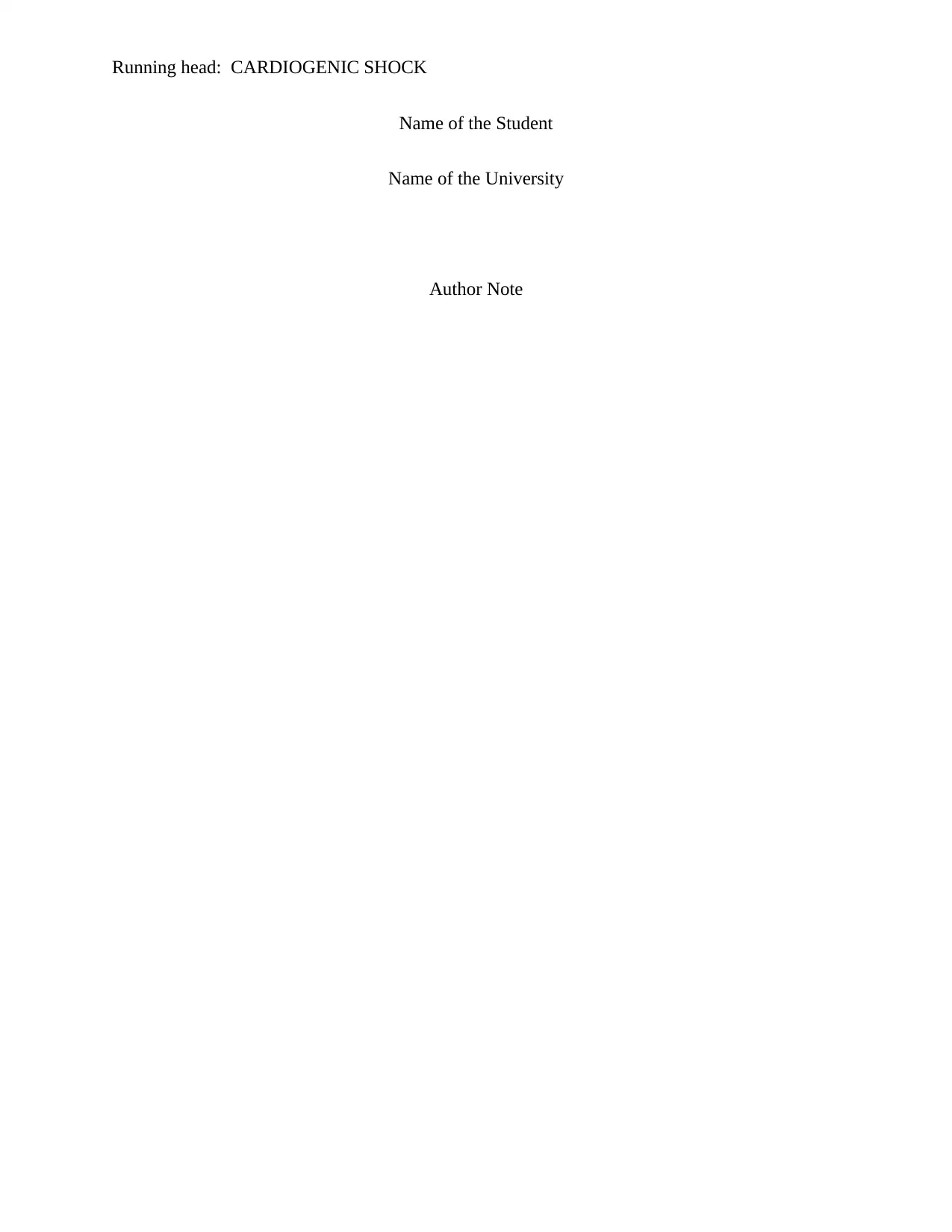
Running head: CARDIOGENIC SHOCK
Name of the Student
Name of the University
Author Note
Name of the Student
Name of the University
Author Note
Paraphrase This Document
Need a fresh take? Get an instant paraphrase of this document with our AI Paraphraser
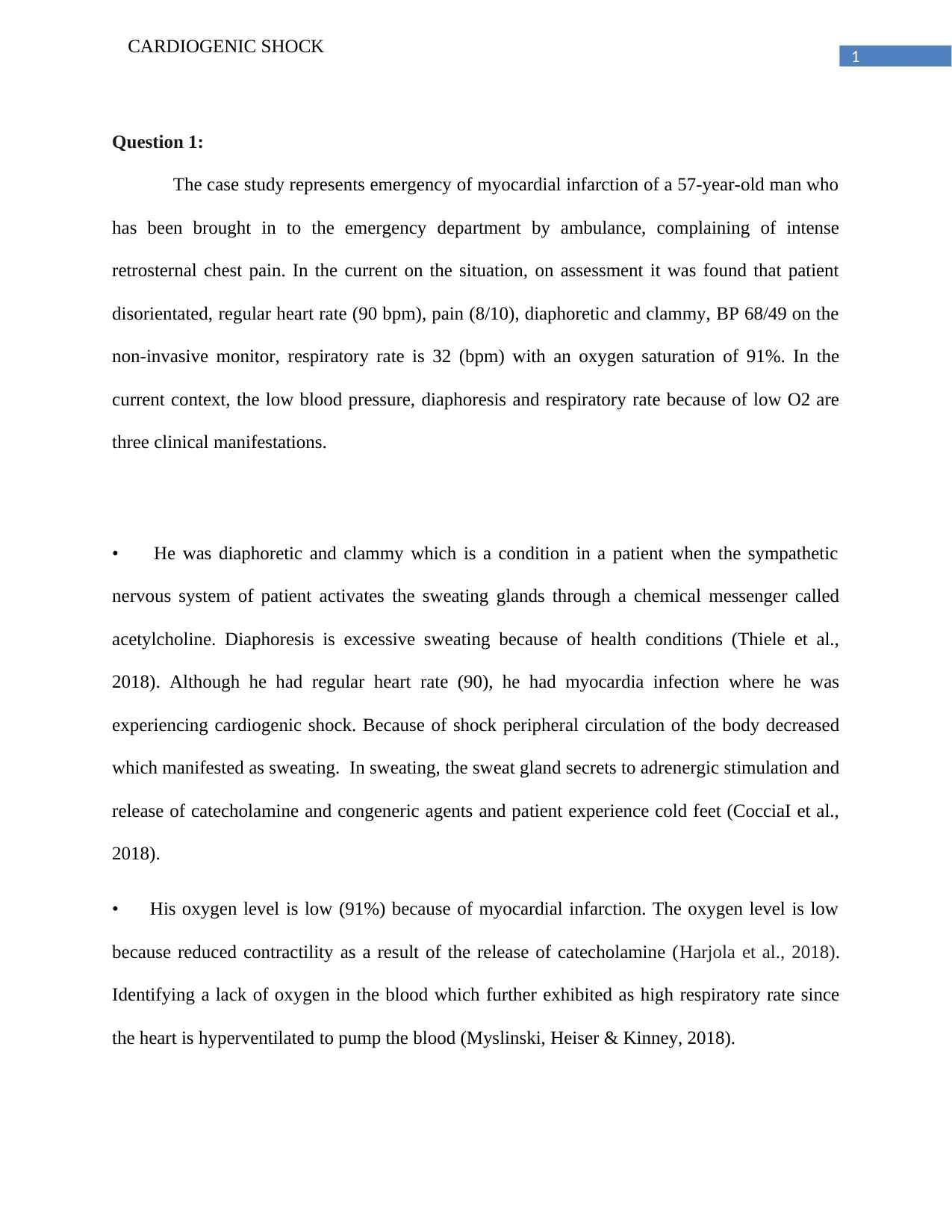
1
CARDIOGENIC SHOCK
Question 1:
The case study represents emergency of myocardial infarction of a 57-year-old man who
has been brought in to the emergency department by ambulance, complaining of intense
retrosternal chest pain. In the current on the situation, on assessment it was found that patient
disorientated, regular heart rate (90 bpm), pain (8/10), diaphoretic and clammy, BP 68/49 on the
non-invasive monitor, respiratory rate is 32 (bpm) with an oxygen saturation of 91%. In the
current context, the low blood pressure, diaphoresis and respiratory rate because of low O2 are
three clinical manifestations.
• He was diaphoretic and clammy which is a condition in a patient when the sympathetic
nervous system of patient activates the sweating glands through a chemical messenger called
acetylcholine. Diaphoresis is excessive sweating because of health conditions (Thiele et al.,
2018). Although he had regular heart rate (90), he had myocardia infection where he was
experiencing cardiogenic shock. Because of shock peripheral circulation of the body decreased
which manifested as sweating. In sweating, the sweat gland secrets to adrenergic stimulation and
release of catecholamine and congeneric agents and patient experience cold feet (CocciaI et al.,
2018).
• His oxygen level is low (91%) because of myocardial infarction. The oxygen level is low
because reduced contractility as a result of the release of catecholamine (Harjola et al., 2018).
Identifying a lack of oxygen in the blood which further exhibited as high respiratory rate since
the heart is hyperventilated to pump the blood (Myslinski, Heiser & Kinney, 2018).
CARDIOGENIC SHOCK
Question 1:
The case study represents emergency of myocardial infarction of a 57-year-old man who
has been brought in to the emergency department by ambulance, complaining of intense
retrosternal chest pain. In the current on the situation, on assessment it was found that patient
disorientated, regular heart rate (90 bpm), pain (8/10), diaphoretic and clammy, BP 68/49 on the
non-invasive monitor, respiratory rate is 32 (bpm) with an oxygen saturation of 91%. In the
current context, the low blood pressure, diaphoresis and respiratory rate because of low O2 are
three clinical manifestations.
• He was diaphoretic and clammy which is a condition in a patient when the sympathetic
nervous system of patient activates the sweating glands through a chemical messenger called
acetylcholine. Diaphoresis is excessive sweating because of health conditions (Thiele et al.,
2018). Although he had regular heart rate (90), he had myocardia infection where he was
experiencing cardiogenic shock. Because of shock peripheral circulation of the body decreased
which manifested as sweating. In sweating, the sweat gland secrets to adrenergic stimulation and
release of catecholamine and congeneric agents and patient experience cold feet (CocciaI et al.,
2018).
• His oxygen level is low (91%) because of myocardial infarction. The oxygen level is low
because reduced contractility as a result of the release of catecholamine (Harjola et al., 2018).
Identifying a lack of oxygen in the blood which further exhibited as high respiratory rate since
the heart is hyperventilated to pump the blood (Myslinski, Heiser & Kinney, 2018).
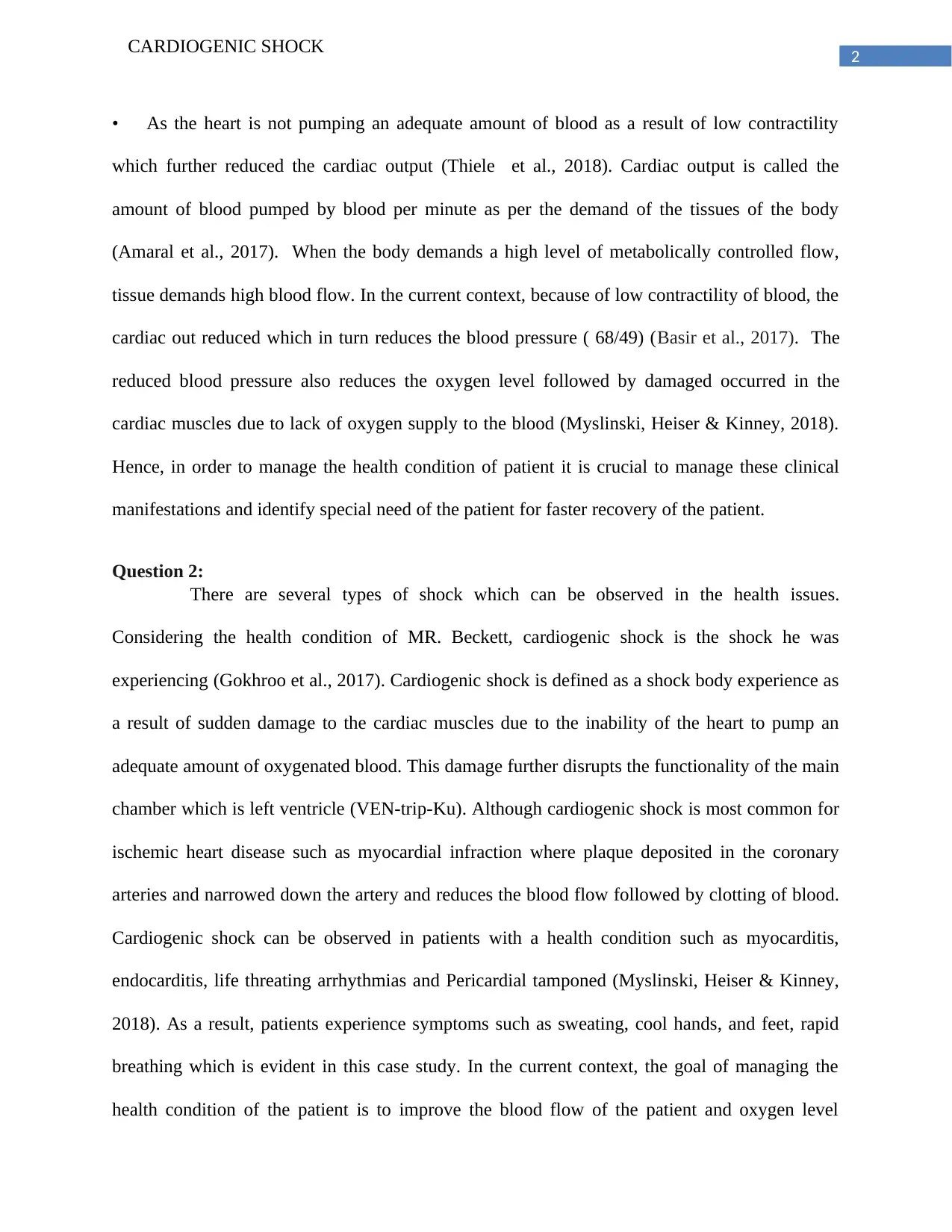
2
CARDIOGENIC SHOCK
• As the heart is not pumping an adequate amount of blood as a result of low contractility
which further reduced the cardiac output (Thiele et al., 2018). Cardiac output is called the
amount of blood pumped by blood per minute as per the demand of the tissues of the body
(Amaral et al., 2017). When the body demands a high level of metabolically controlled flow,
tissue demands high blood flow. In the current context, because of low contractility of blood, the
cardiac out reduced which in turn reduces the blood pressure ( 68/49) (Basir et al., 2017). The
reduced blood pressure also reduces the oxygen level followed by damaged occurred in the
cardiac muscles due to lack of oxygen supply to the blood (Myslinski, Heiser & Kinney, 2018).
Hence, in order to manage the health condition of patient it is crucial to manage these clinical
manifestations and identify special need of the patient for faster recovery of the patient.
Question 2:
There are several types of shock which can be observed in the health issues.
Considering the health condition of MR. Beckett, cardiogenic shock is the shock he was
experiencing (Gokhroo et al., 2017). Cardiogenic shock is defined as a shock body experience as
a result of sudden damage to the cardiac muscles due to the inability of the heart to pump an
adequate amount of oxygenated blood. This damage further disrupts the functionality of the main
chamber which is left ventricle (VEN-trip-Ku). Although cardiogenic shock is most common for
ischemic heart disease such as myocardial infraction where plaque deposited in the coronary
arteries and narrowed down the artery and reduces the blood flow followed by clotting of blood.
Cardiogenic shock can be observed in patients with a health condition such as myocarditis,
endocarditis, life threating arrhythmias and Pericardial tamponed (Myslinski, Heiser & Kinney,
2018). As a result, patients experience symptoms such as sweating, cool hands, and feet, rapid
breathing which is evident in this case study. In the current context, the goal of managing the
health condition of the patient is to improve the blood flow of the patient and oxygen level
CARDIOGENIC SHOCK
• As the heart is not pumping an adequate amount of blood as a result of low contractility
which further reduced the cardiac output (Thiele et al., 2018). Cardiac output is called the
amount of blood pumped by blood per minute as per the demand of the tissues of the body
(Amaral et al., 2017). When the body demands a high level of metabolically controlled flow,
tissue demands high blood flow. In the current context, because of low contractility of blood, the
cardiac out reduced which in turn reduces the blood pressure ( 68/49) (Basir et al., 2017). The
reduced blood pressure also reduces the oxygen level followed by damaged occurred in the
cardiac muscles due to lack of oxygen supply to the blood (Myslinski, Heiser & Kinney, 2018).
Hence, in order to manage the health condition of patient it is crucial to manage these clinical
manifestations and identify special need of the patient for faster recovery of the patient.
Question 2:
There are several types of shock which can be observed in the health issues.
Considering the health condition of MR. Beckett, cardiogenic shock is the shock he was
experiencing (Gokhroo et al., 2017). Cardiogenic shock is defined as a shock body experience as
a result of sudden damage to the cardiac muscles due to the inability of the heart to pump an
adequate amount of oxygenated blood. This damage further disrupts the functionality of the main
chamber which is left ventricle (VEN-trip-Ku). Although cardiogenic shock is most common for
ischemic heart disease such as myocardial infraction where plaque deposited in the coronary
arteries and narrowed down the artery and reduces the blood flow followed by clotting of blood.
Cardiogenic shock can be observed in patients with a health condition such as myocarditis,
endocarditis, life threating arrhythmias and Pericardial tamponed (Myslinski, Heiser & Kinney,
2018). As a result, patients experience symptoms such as sweating, cool hands, and feet, rapid
breathing which is evident in this case study. In the current context, the goal of managing the
health condition of the patient is to improve the blood flow of the patient and oxygen level
⊘ This is a preview!⊘
Do you want full access?
Subscribe today to unlock all pages.

Trusted by 1+ million students worldwide
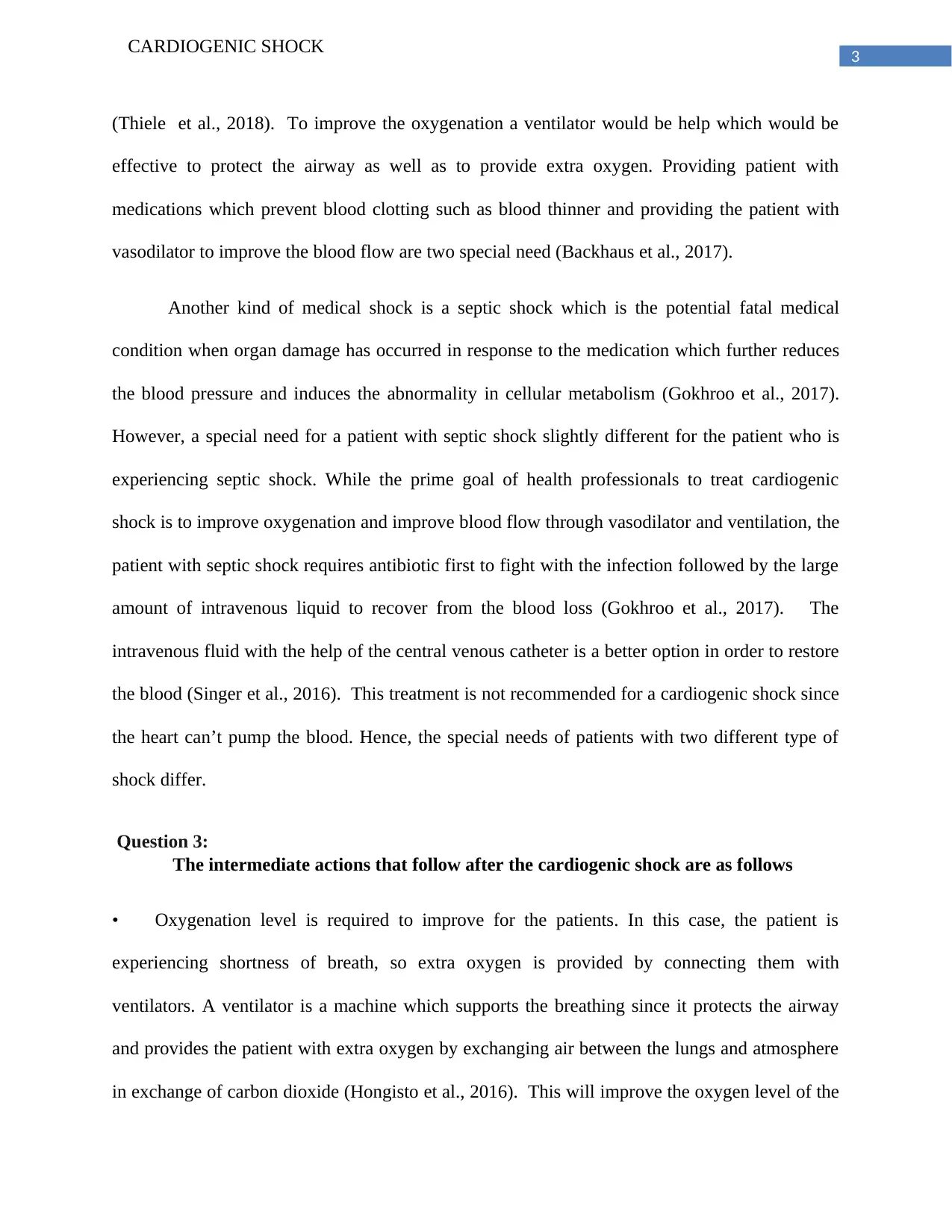
3
CARDIOGENIC SHOCK
(Thiele et al., 2018). To improve the oxygenation a ventilator would be help which would be
effective to protect the airway as well as to provide extra oxygen. Providing patient with
medications which prevent blood clotting such as blood thinner and providing the patient with
vasodilator to improve the blood flow are two special need (Backhaus et al., 2017).
Another kind of medical shock is a septic shock which is the potential fatal medical
condition when organ damage has occurred in response to the medication which further reduces
the blood pressure and induces the abnormality in cellular metabolism (Gokhroo et al., 2017).
However, a special need for a patient with septic shock slightly different for the patient who is
experiencing septic shock. While the prime goal of health professionals to treat cardiogenic
shock is to improve oxygenation and improve blood flow through vasodilator and ventilation, the
patient with septic shock requires antibiotic first to fight with the infection followed by the large
amount of intravenous liquid to recover from the blood loss (Gokhroo et al., 2017). The
intravenous fluid with the help of the central venous catheter is a better option in order to restore
the blood (Singer et al., 2016). This treatment is not recommended for a cardiogenic shock since
the heart can’t pump the blood. Hence, the special needs of patients with two different type of
shock differ.
Question 3:
The intermediate actions that follow after the cardiogenic shock are as follows
• Oxygenation level is required to improve for the patients. In this case, the patient is
experiencing shortness of breath, so extra oxygen is provided by connecting them with
ventilators. A ventilator is a machine which supports the breathing since it protects the airway
and provides the patient with extra oxygen by exchanging air between the lungs and atmosphere
in exchange of carbon dioxide (Hongisto et al., 2016). This will improve the oxygen level of the
CARDIOGENIC SHOCK
(Thiele et al., 2018). To improve the oxygenation a ventilator would be help which would be
effective to protect the airway as well as to provide extra oxygen. Providing patient with
medications which prevent blood clotting such as blood thinner and providing the patient with
vasodilator to improve the blood flow are two special need (Backhaus et al., 2017).
Another kind of medical shock is a septic shock which is the potential fatal medical
condition when organ damage has occurred in response to the medication which further reduces
the blood pressure and induces the abnormality in cellular metabolism (Gokhroo et al., 2017).
However, a special need for a patient with septic shock slightly different for the patient who is
experiencing septic shock. While the prime goal of health professionals to treat cardiogenic
shock is to improve oxygenation and improve blood flow through vasodilator and ventilation, the
patient with septic shock requires antibiotic first to fight with the infection followed by the large
amount of intravenous liquid to recover from the blood loss (Gokhroo et al., 2017). The
intravenous fluid with the help of the central venous catheter is a better option in order to restore
the blood (Singer et al., 2016). This treatment is not recommended for a cardiogenic shock since
the heart can’t pump the blood. Hence, the special needs of patients with two different type of
shock differ.
Question 3:
The intermediate actions that follow after the cardiogenic shock are as follows
• Oxygenation level is required to improve for the patients. In this case, the patient is
experiencing shortness of breath, so extra oxygen is provided by connecting them with
ventilators. A ventilator is a machine which supports the breathing since it protects the airway
and provides the patient with extra oxygen by exchanging air between the lungs and atmosphere
in exchange of carbon dioxide (Hongisto et al., 2016). This will improve the oxygen level of the
Paraphrase This Document
Need a fresh take? Get an instant paraphrase of this document with our AI Paraphraser
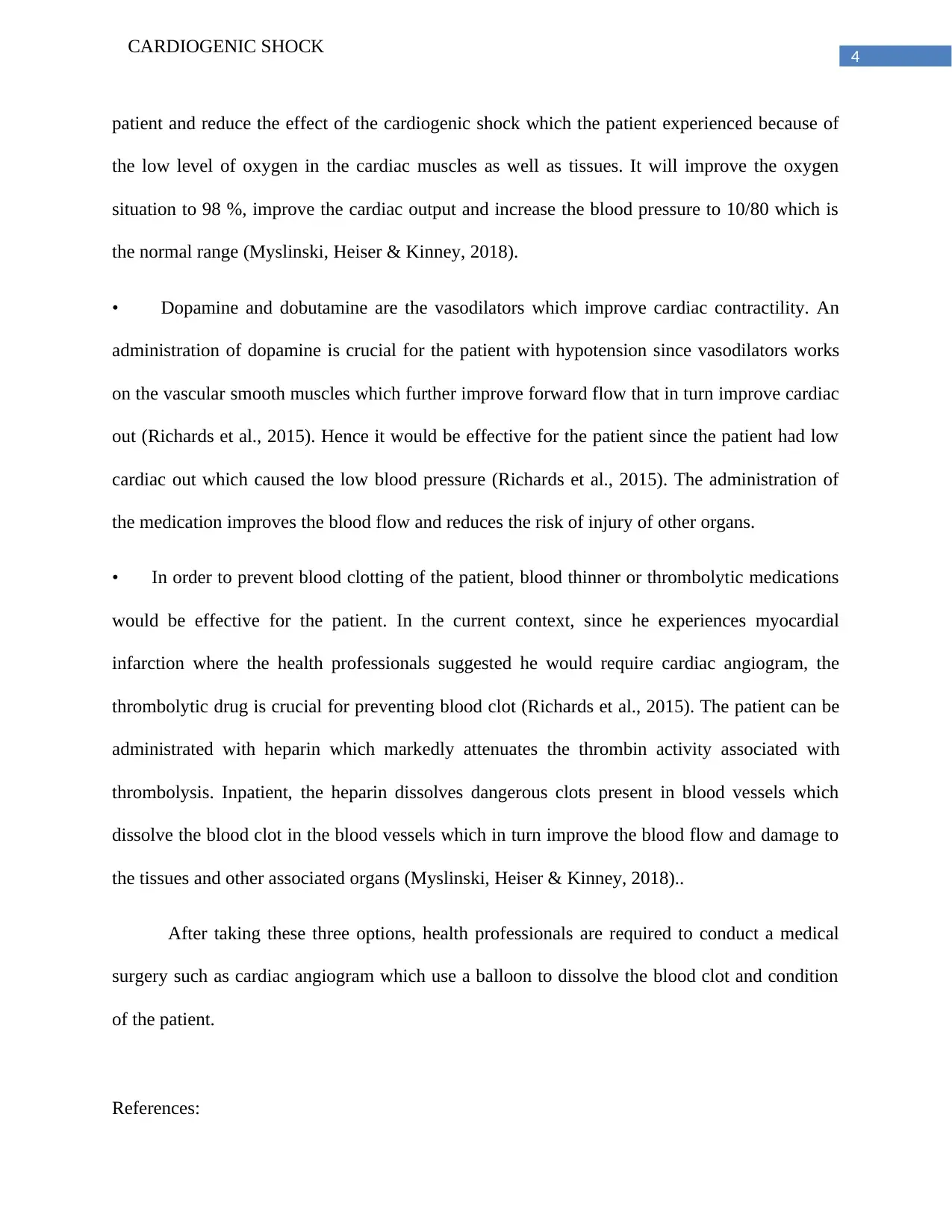
4
CARDIOGENIC SHOCK
patient and reduce the effect of the cardiogenic shock which the patient experienced because of
the low level of oxygen in the cardiac muscles as well as tissues. It will improve the oxygen
situation to 98 %, improve the cardiac output and increase the blood pressure to 10/80 which is
the normal range (Myslinski, Heiser & Kinney, 2018).
• Dopamine and dobutamine are the vasodilators which improve cardiac contractility. An
administration of dopamine is crucial for the patient with hypotension since vasodilators works
on the vascular smooth muscles which further improve forward flow that in turn improve cardiac
out (Richards et al., 2015). Hence it would be effective for the patient since the patient had low
cardiac out which caused the low blood pressure (Richards et al., 2015). The administration of
the medication improves the blood flow and reduces the risk of injury of other organs.
• In order to prevent blood clotting of the patient, blood thinner or thrombolytic medications
would be effective for the patient. In the current context, since he experiences myocardial
infarction where the health professionals suggested he would require cardiac angiogram, the
thrombolytic drug is crucial for preventing blood clot (Richards et al., 2015). The patient can be
administrated with heparin which markedly attenuates the thrombin activity associated with
thrombolysis. Inpatient, the heparin dissolves dangerous clots present in blood vessels which
dissolve the blood clot in the blood vessels which in turn improve the blood flow and damage to
the tissues and other associated organs (Myslinski, Heiser & Kinney, 2018)..
After taking these three options, health professionals are required to conduct a medical
surgery such as cardiac angiogram which use a balloon to dissolve the blood clot and condition
of the patient.
References:
CARDIOGENIC SHOCK
patient and reduce the effect of the cardiogenic shock which the patient experienced because of
the low level of oxygen in the cardiac muscles as well as tissues. It will improve the oxygen
situation to 98 %, improve the cardiac output and increase the blood pressure to 10/80 which is
the normal range (Myslinski, Heiser & Kinney, 2018).
• Dopamine and dobutamine are the vasodilators which improve cardiac contractility. An
administration of dopamine is crucial for the patient with hypotension since vasodilators works
on the vascular smooth muscles which further improve forward flow that in turn improve cardiac
out (Richards et al., 2015). Hence it would be effective for the patient since the patient had low
cardiac out which caused the low blood pressure (Richards et al., 2015). The administration of
the medication improves the blood flow and reduces the risk of injury of other organs.
• In order to prevent blood clotting of the patient, blood thinner or thrombolytic medications
would be effective for the patient. In the current context, since he experiences myocardial
infarction where the health professionals suggested he would require cardiac angiogram, the
thrombolytic drug is crucial for preventing blood clot (Richards et al., 2015). The patient can be
administrated with heparin which markedly attenuates the thrombin activity associated with
thrombolysis. Inpatient, the heparin dissolves dangerous clots present in blood vessels which
dissolve the blood clot in the blood vessels which in turn improve the blood flow and damage to
the tissues and other associated organs (Myslinski, Heiser & Kinney, 2018)..
After taking these three options, health professionals are required to conduct a medical
surgery such as cardiac angiogram which use a balloon to dissolve the blood clot and condition
of the patient.
References:
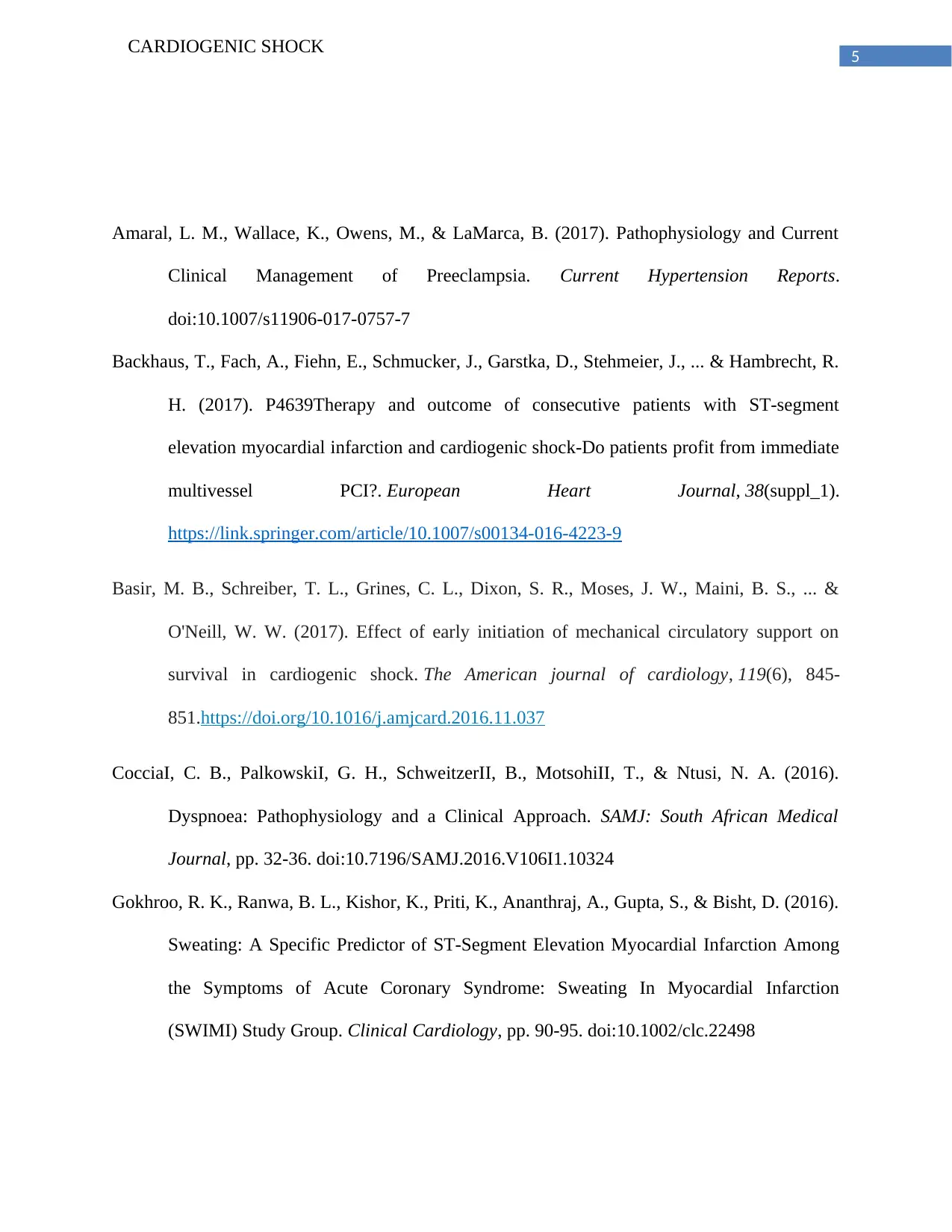
5
CARDIOGENIC SHOCK
Amaral, L. M., Wallace, K., Owens, M., & LaMarca, B. (2017). Pathophysiology and Current
Clinical Management of Preeclampsia. Current Hypertension Reports.
doi:10.1007/s11906-017-0757-7
Backhaus, T., Fach, A., Fiehn, E., Schmucker, J., Garstka, D., Stehmeier, J., ... & Hambrecht, R.
H. (2017). P4639Therapy and outcome of consecutive patients with ST-segment
elevation myocardial infarction and cardiogenic shock-Do patients profit from immediate
multivessel PCI?. European Heart Journal, 38(suppl_1).
https://link.springer.com/article/10.1007/s00134-016-4223-9
Basir, M. B., Schreiber, T. L., Grines, C. L., Dixon, S. R., Moses, J. W., Maini, B. S., ... &
O'Neill, W. W. (2017). Effect of early initiation of mechanical circulatory support on
survival in cardiogenic shock. The American journal of cardiology, 119(6), 845-
851.https://doi.org/10.1016/j.amjcard.2016.11.037
CocciaI, C. B., PalkowskiI, G. H., SchweitzerII, B., MotsohiII, T., & Ntusi, N. A. (2016).
Dyspnoea: Pathophysiology and a Clinical Approach. SAMJ: South African Medical
Journal, pp. 32-36. doi:10.7196/SAMJ.2016.V106I1.10324
Gokhroo, R. K., Ranwa, B. L., Kishor, K., Priti, K., Ananthraj, A., Gupta, S., & Bisht, D. (2016).
Sweating: A Specific Predictor of ST-Segment Elevation Myocardial Infarction Among
the Symptoms of Acute Coronary Syndrome: Sweating In Myocardial Infarction
(SWIMI) Study Group. Clinical Cardiology, pp. 90-95. doi:10.1002/clc.22498
CARDIOGENIC SHOCK
Amaral, L. M., Wallace, K., Owens, M., & LaMarca, B. (2017). Pathophysiology and Current
Clinical Management of Preeclampsia. Current Hypertension Reports.
doi:10.1007/s11906-017-0757-7
Backhaus, T., Fach, A., Fiehn, E., Schmucker, J., Garstka, D., Stehmeier, J., ... & Hambrecht, R.
H. (2017). P4639Therapy and outcome of consecutive patients with ST-segment
elevation myocardial infarction and cardiogenic shock-Do patients profit from immediate
multivessel PCI?. European Heart Journal, 38(suppl_1).
https://link.springer.com/article/10.1007/s00134-016-4223-9
Basir, M. B., Schreiber, T. L., Grines, C. L., Dixon, S. R., Moses, J. W., Maini, B. S., ... &
O'Neill, W. W. (2017). Effect of early initiation of mechanical circulatory support on
survival in cardiogenic shock. The American journal of cardiology, 119(6), 845-
851.https://doi.org/10.1016/j.amjcard.2016.11.037
CocciaI, C. B., PalkowskiI, G. H., SchweitzerII, B., MotsohiII, T., & Ntusi, N. A. (2016).
Dyspnoea: Pathophysiology and a Clinical Approach. SAMJ: South African Medical
Journal, pp. 32-36. doi:10.7196/SAMJ.2016.V106I1.10324
Gokhroo, R. K., Ranwa, B. L., Kishor, K., Priti, K., Ananthraj, A., Gupta, S., & Bisht, D. (2016).
Sweating: A Specific Predictor of ST-Segment Elevation Myocardial Infarction Among
the Symptoms of Acute Coronary Syndrome: Sweating In Myocardial Infarction
(SWIMI) Study Group. Clinical Cardiology, pp. 90-95. doi:10.1002/clc.22498
⊘ This is a preview!⊘
Do you want full access?
Subscribe today to unlock all pages.

Trusted by 1+ million students worldwide
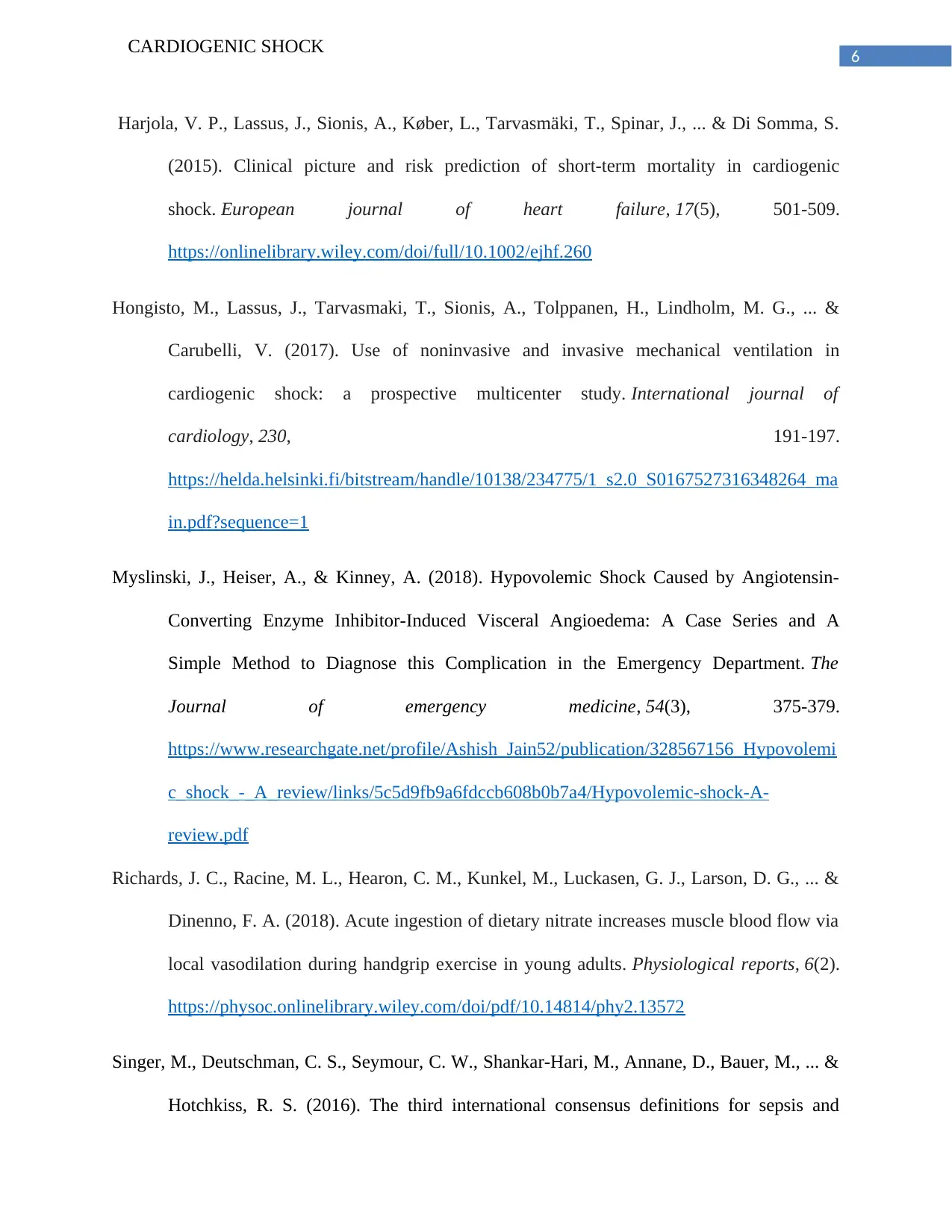
6
CARDIOGENIC SHOCK
Harjola, V. P., Lassus, J., Sionis, A., Køber, L., Tarvasmäki, T., Spinar, J., ... & Di Somma, S.
(2015). Clinical picture and risk prediction of short‐term mortality in cardiogenic
shock. European journal of heart failure, 17(5), 501-509.
https://onlinelibrary.wiley.com/doi/full/10.1002/ejhf.260
Hongisto, M., Lassus, J., Tarvasmaki, T., Sionis, A., Tolppanen, H., Lindholm, M. G., ... &
Carubelli, V. (2017). Use of noninvasive and invasive mechanical ventilation in
cardiogenic shock: a prospective multicenter study. International journal of
cardiology, 230, 191-197.
https://helda.helsinki.fi/bitstream/handle/10138/234775/1_s2.0_S0167527316348264_ma
in.pdf?sequence=1
Myslinski, J., Heiser, A., & Kinney, A. (2018). Hypovolemic Shock Caused by Angiotensin-
Converting Enzyme Inhibitor-Induced Visceral Angioedema: A Case Series and A
Simple Method to Diagnose this Complication in the Emergency Department. The
Journal of emergency medicine, 54(3), 375-379.
https://www.researchgate.net/profile/Ashish_Jain52/publication/328567156_Hypovolemi
c_shock_-_A_review/links/5c5d9fb9a6fdccb608b0b7a4/Hypovolemic-shock-A-
review.pdf
Richards, J. C., Racine, M. L., Hearon, C. M., Kunkel, M., Luckasen, G. J., Larson, D. G., ... &
Dinenno, F. A. (2018). Acute ingestion of dietary nitrate increases muscle blood flow via
local vasodilation during handgrip exercise in young adults. Physiological reports, 6(2).
https://physoc.onlinelibrary.wiley.com/doi/pdf/10.14814/phy2.13572
Singer, M., Deutschman, C. S., Seymour, C. W., Shankar-Hari, M., Annane, D., Bauer, M., ... &
Hotchkiss, R. S. (2016). The third international consensus definitions for sepsis and
CARDIOGENIC SHOCK
Harjola, V. P., Lassus, J., Sionis, A., Køber, L., Tarvasmäki, T., Spinar, J., ... & Di Somma, S.
(2015). Clinical picture and risk prediction of short‐term mortality in cardiogenic
shock. European journal of heart failure, 17(5), 501-509.
https://onlinelibrary.wiley.com/doi/full/10.1002/ejhf.260
Hongisto, M., Lassus, J., Tarvasmaki, T., Sionis, A., Tolppanen, H., Lindholm, M. G., ... &
Carubelli, V. (2017). Use of noninvasive and invasive mechanical ventilation in
cardiogenic shock: a prospective multicenter study. International journal of
cardiology, 230, 191-197.
https://helda.helsinki.fi/bitstream/handle/10138/234775/1_s2.0_S0167527316348264_ma
in.pdf?sequence=1
Myslinski, J., Heiser, A., & Kinney, A. (2018). Hypovolemic Shock Caused by Angiotensin-
Converting Enzyme Inhibitor-Induced Visceral Angioedema: A Case Series and A
Simple Method to Diagnose this Complication in the Emergency Department. The
Journal of emergency medicine, 54(3), 375-379.
https://www.researchgate.net/profile/Ashish_Jain52/publication/328567156_Hypovolemi
c_shock_-_A_review/links/5c5d9fb9a6fdccb608b0b7a4/Hypovolemic-shock-A-
review.pdf
Richards, J. C., Racine, M. L., Hearon, C. M., Kunkel, M., Luckasen, G. J., Larson, D. G., ... &
Dinenno, F. A. (2018). Acute ingestion of dietary nitrate increases muscle blood flow via
local vasodilation during handgrip exercise in young adults. Physiological reports, 6(2).
https://physoc.onlinelibrary.wiley.com/doi/pdf/10.14814/phy2.13572
Singer, M., Deutschman, C. S., Seymour, C. W., Shankar-Hari, M., Annane, D., Bauer, M., ... &
Hotchkiss, R. S. (2016). The third international consensus definitions for sepsis and
Paraphrase This Document
Need a fresh take? Get an instant paraphrase of this document with our AI Paraphraser
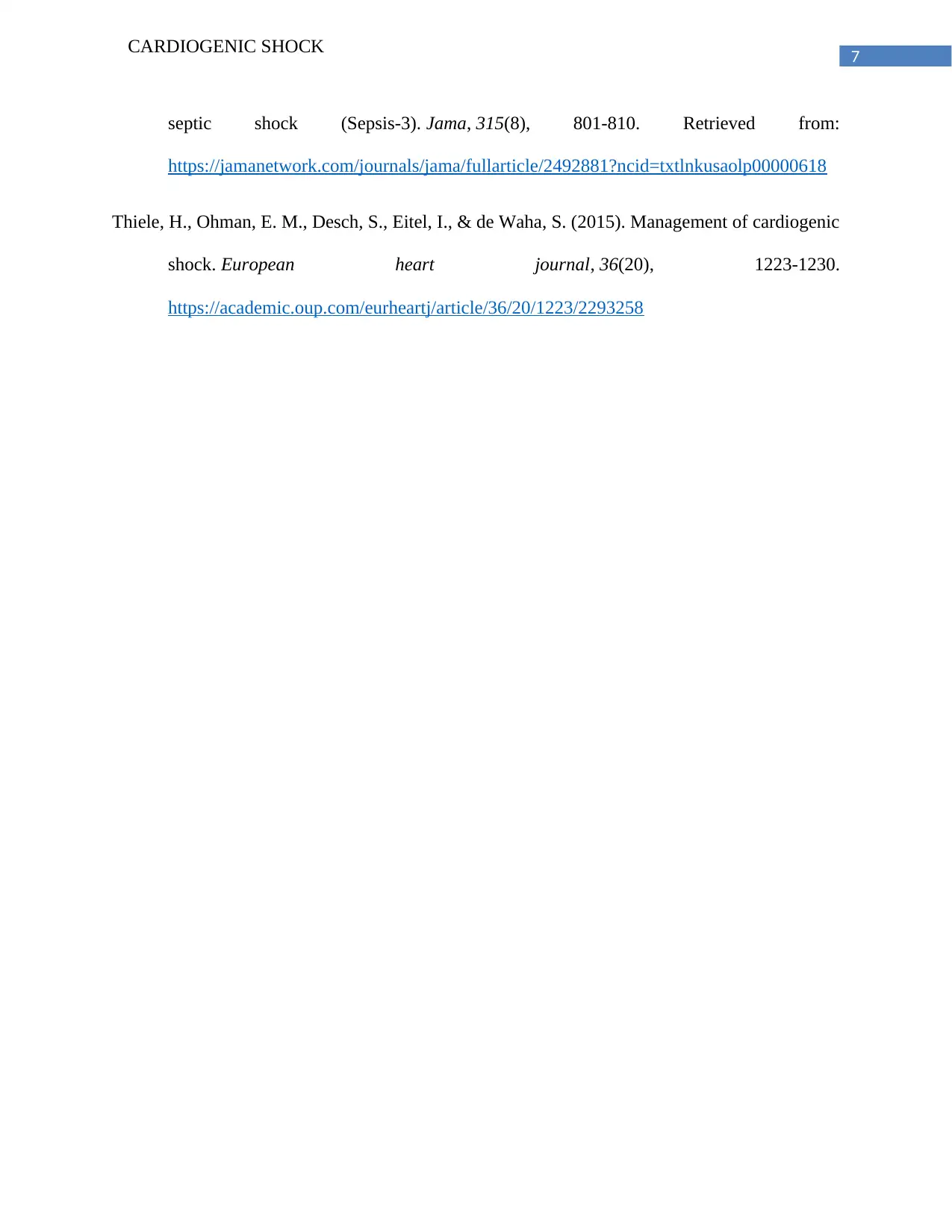
7
CARDIOGENIC SHOCK
septic shock (Sepsis-3). Jama, 315(8), 801-810. Retrieved from:
https://jamanetwork.com/journals/jama/fullarticle/2492881?ncid=txtlnkusaolp00000618
Thiele, H., Ohman, E. M., Desch, S., Eitel, I., & de Waha, S. (2015). Management of cardiogenic
shock. European heart journal, 36(20), 1223-1230.
https://academic.oup.com/eurheartj/article/36/20/1223/2293258
CARDIOGENIC SHOCK
septic shock (Sepsis-3). Jama, 315(8), 801-810. Retrieved from:
https://jamanetwork.com/journals/jama/fullarticle/2492881?ncid=txtlnkusaolp00000618
Thiele, H., Ohman, E. M., Desch, S., Eitel, I., & de Waha, S. (2015). Management of cardiogenic
shock. European heart journal, 36(20), 1223-1230.
https://academic.oup.com/eurheartj/article/36/20/1223/2293258
1 out of 8
Related Documents
Your All-in-One AI-Powered Toolkit for Academic Success.
+13062052269
info@desklib.com
Available 24*7 on WhatsApp / Email
![[object Object]](/_next/static/media/star-bottom.7253800d.svg)
Unlock your academic potential
Copyright © 2020–2025 A2Z Services. All Rights Reserved. Developed and managed by ZUCOL.





